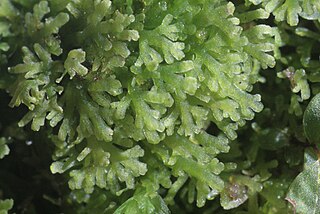
Metzgeriales is an order of liverworts. The group is sometimes called the simple thalloid liverworts: "thalloid" because the members lack structures resembling stems or leaves, and "simple" because their tissues are thin and relatively undifferentiated. All species in the order have a small gametophyte stage and a smaller, relatively short-lived, spore-bearing stage. Although these plants are almost entirely restricted to regions with high humidity or readily available moisture, the group as a whole is widely distributed, and occurs on every continent except Antarctica.

Jungermanniaceae is the namesake family of leafy liverworts. It is a group of small plants that are widely distributed. Several genera formerly included within the family are now classified in the Myliaceae or Solenostomataceae.

Lepidoziaceae is a family of leafy liverworts. It is a group of small plants that are widely distributed.

Aneuraceae is a family of thallose liverworts in the order Metzgeriales. Most species are very small with narrow, branching thalli.

Treubia is a genus of liverworts in the family Treubiaceae. There are seven species, all of which are restricted to the southern hemisphere. Five of the species occur in Australasia and the other occurs in Chile. All species are dioicous, with separate male and female gametophytes.
Aneura mirabilis is a species of liverworts in the family Aneuraceae. It was first described in 1933, as Cryptothallus mirabilis. Plants of this species are white as a result of lacking chlorophyll, and their plastids do not differentiate into chloroplasts.
Cryptothallus is a previously recognized genus of liverworts in the family Aneuraceae. The plants are small, and are white to pale green as a result of lacking chlorophyll. This feature led to the creation of a separate genus. The morphology of species assigned to Cryptothallus is very similar to that of Aneura. As a result, Karen Renzaglia in 1982 suggested that the only species then placed in the genus, Cryptothallus mirabilis, may be considered "merely as an achlorophyllous species of Aneura." Wickett and Goffinet argued the same position on the basis of sequences of nuclear, mitochondrial, and plastid DNA, and moved Cryptothallus mirabilis to Aneura. A 2010 molecular phylogenetic study confirmed the position of Cryptothallus within Aneura. This was accepted in the 2016 world checklist of hornworts and liverworts.

Pleurozia is the only genus of liverworts in the family Pleuroziaceae, which is now classified in its own order Pleuroziales, but was previously included in a broader circumscription of the Jungermanniales. The genus includes twelve species, and as a whole is both physically distinctive and widely distributed.

Solenostomataceae is a family of liverworts in the order Jungermanniales.

Lophoziaceae is a family of liverworts belonging to the order Jungermanniales.

Acrobolbaceae is liverwort family in the order Jungermanniales.

Cephaloziaceae is a family of liverworts.

Calypogeiaceae is a family of liverworts. This type of plant is a calcifuge.

Aneura is a genus of liverworts in the family Aneuraceae.
Anastrophyllaceae is a family of liverworts belonging to the order Jungermanniales.
Balantiopsidaceae is a family of liverworts belonging to the order Jungermanniales.

Cephaloziellaceae is a family of liverworts belonging to the order Jungermanniales.
Cleveaceae is a family of liverworts belonging to the order Marchantiales.
Lepidolaenaceae is a family of liverworts belonging to the order Porellales.
Lophocoleaceae is a family of liverworts belonging to the order Jungermanniales.













